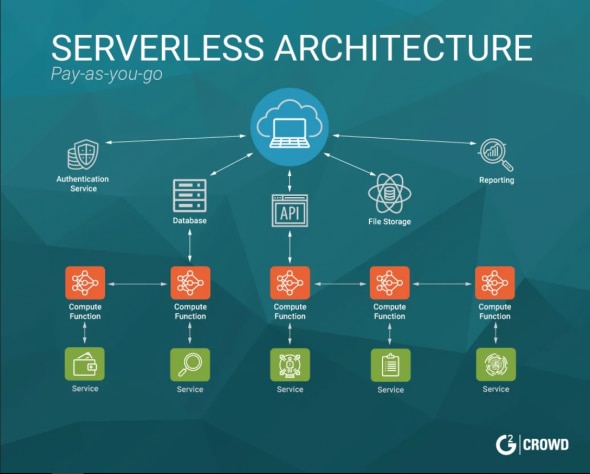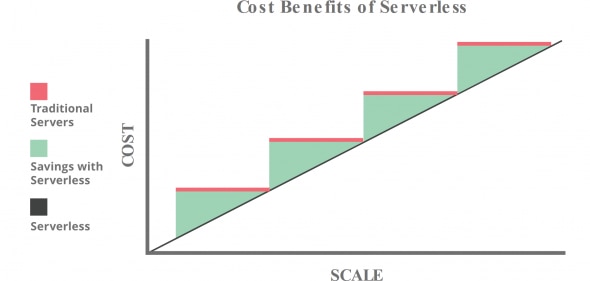Cloud computing has brought enormous change to the world of applications. It makes long-standing constraints on application development and deployment disappear. It’s no exaggeration that most of the innovation in IT over the past decade has been enabled, catalyzed, or caused by cloud computing.
Lately, a new cloud-based technology has emerged that has the potential to drastically alter the existing tech ecosystem. It’s called serverless computing.
How One AI-Driven Media Platform Cut EBS Costs for AWS ASGs by 48%

In this article we define serverless computing, and take a look at its benefits.
What is serverless computing
In the early days of the web, anyone who wanted to build a web application had to own the physical hardware required to run a server, which is a cumbersome and expensive undertaking.
Then came the cloud, where fixed numbers of servers or amounts of server space could be rented remotely. Developers and companies who rent these fixed units of server space generally over-purchase to ensure that a spike in traffic or activity wouldn’t exceed their monthly limits and break their applications. This meant that much of the server space that was paid for usually went to waste. Cloud vendors have introduced auto-scaling models to address the issue, but even with auto-scaling an unwanted spike in activity, such as a DDoS attack, could end up being very expensive.
Serverless is a cloud computing execution model where the cloud provider dynamically manages the allocation and provisioning of servers. A serverless application runs in stateless compute containers that are event-triggered, ephemeral (may last for one invocation), and fully managed by the cloud provider. Pricing is based on the number of executions rather than pre-purchased compute capacity.

Why use serverless
Serverless computing offers a number of advantages over traditional cloud-based or server-centric infrastructure. For many developers, serverless architectures offer greater scalability, more flexibility, and quicker time to release, all at a reduced cost. With serverless architectures, developers do not need to worry about purchasing, provisioning, and managing backend servers. However, serverless computing is not a magic bullet for all web application developers.
Serverless computing can simplify the process of deploying code into production. Scaling, capacity planning and maintenance operations may be hidden from the developer or operator. Serverless code can be used in conjunction with code deployed in traditional styles, such as microservices. Alternatively, applications can be written to be purely serverless and use no provisioned servers at all.
The difference between traditional cloud computing and serverless is that you, the customer who requires the computing, doesn’t pay for underutilized resources. Instead of spinning up a server in AWS for example, you’re just spinning up some code execution time. The serverless computing service takes your functions as input, performs logic, returns your output, and then shuts down. You are only billed for the resources used during the execution of those functions.

What are the advantages of serverless computing?
Let’s take a look at the advantages serverless computing offers to businesses:
Lower costs
Serverless computing is generally very cost-effective, as traditional cloud providers of backend services (server allocation) often result in the user paying for unused space or idle CPU time.
No server management
Although ‘serverless’ computing does actually takes place on servers, developers never have to deal with the servers. They are managed by the vendor. This can reduce the investment necessary in DevOps, which lowers expenses, and it also frees up developers to create and expand their applications without being constrained by server capacity.
Simplified scalability
Developers using serverless architecture don’t have to worry about policies to scale up their code. The serverless vendor handles all of the scaling on demand. As a result, a serverless application will be able to handle an unusually high number of requests just as well as it can process a single request from a single user. A traditionally structured application with a fixed amount of server space can be overwhelmed by a sudden increase in usage.
Quick deployments and updates
Using a serverless infrastructure, there is no need to upload code to servers or do any backend configuration in order to release a working version of an application. Developers can very quickly upload bits of code and release a new product. They can upload code all at once or one function at a time, since the application is not a single monolithic stack but rather a collection of functions provisioned by the vendor.
Simplified backend code
Because the application is not hosted on an origin server, its code can be run from anywhere. It is therefore possible, depending on the vendor used, to run application functions on servers that are close to the end user. This reduces latency because requests from the user no longer have to travel all the way to an origin server
Quicker turnaround
Serverless architecture can significantly cut time to market. Instead of needing a complicated deploy process to roll out bug fixes and new features, developers can add and modify code on a piecemeal basis.
Serverless vs Containers
Both serverless computing and containers enable developers to build applications with far less overhead and more flexibility than applications hosted on traditional servers or virtual machines. Which style of architecture a developer should use depends on the needs of the application, but serverless applications are more scalable and usually more cost-effective.
Containers provide a lighter-weight execution environment, making instantiation faster and increasing hardware utilization, but they don’t change the fundamental application operations process. Users are still expected to take on the lion’s share of making sure the application remains up and running.
With serverless, the cloud provider takes on the responsibility of making sure that the application code gets loaded and executed, and it ensures that sufficient computing resources are available to run your code, no matter how much processing it requires.
Conclusion
Serverless is a cloud computing execution model where the cloud provider dynamically manages the allocation and provisioning of servers. Serverless computing offers many benefits compared to standard cloud model, including lower costs, simplified scalability, quicker deployemnd etc.
If you have any questions about serverless computing and how it can help you achieve your business goals, contact us today to help you out with your performance and security needs.






